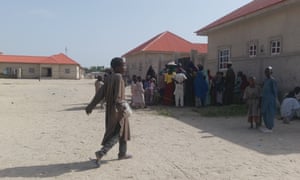Imagine the small African region with more refugees than the whole of Europe?

Ali Kawu,
a 25-year old man, escaped with his wife and their three children, following a raid on his village by the dreaded Boko Haram militants. They left behind their papers, six sacks of beans,
up to 15 dead neighbours, and 10 kidnapped villagers. Then they walked
all day and all night.

“Every minute I would look back to see if they were following us,”
Kawu says, shortly after reaching the safety of Monguno, a town
recaptured from Boko Haram last year. “Walking forward, looking back,
walking forward, looking back. I thought it was the end of my life.”
But safety doesn’t mean comfort. Kawu is just the latest of
approximately 140,000 displaced people sheltering in this remote town of
60,000 people. North-east Nigeria has been hit by a displacement crisis
that dwarfs any migration flows seen in Europe in recent years.
Since the Boko Haram insurgency began, more people have migrated to
Monguno alone than left all of north Africa for Europe in the first nine
months of this year.
One upshot is a food crisis that the UN warns might see hundreds of thousands die from famine next year.
About 40% more people have been displaced throughout Borno state (1.4
million) than reached Europe by boat in 2015 (1 million). Across the
region, the war against Boko Haram has forced more people from their
homes – 2.6 million – than there are Syrians in Turkey, the country that
hosts more refugees than any other.
The comparisons mirror a wider trend across Africa. Of the world’s 17
million displaced Africans, 93.7% remain inside the continent, and just
3.3% have reached Europe, according to UN data supplied privately to
the Guardian.
“No matter how many problems Europeans have, it’s nothing like this,”
summarises Modu Amsami, the informal leader of Monguno’s nine camps for
internally displaced people (IDP), as he strolls past Kawu’s newly
erected hut. “Please, I’m appealing to Europeans to forget their minor
problems. Let them come here and face our major problems.”
For 18 months, Monguno endured its migration crisis largely alone.
Amsami is an IDP but decided to run Monguno’s nine camps himself in the
absence of any government officials. It was not until this June, a year
and a half after the Nigerian army retook the town from Boko Haram, that
aid groups and civil servants felt safe to return.
“We were shaken by what we saw,” says Mathieu Kinde, an aid worker
with Alima, a medical NGO that was the first to arrive. Many people were
starving, having been cut off from their farmland. There was a polio
outbreak – Nigeria’s first case in two years. Just one government doctor
was left in the town.
To this day, the townspeople cannot farm their fields – Boko Haram
remains too close to the town’s perimeter. Aid convoys from Maiduguri,
the state capital, risk ambush. Most food can arrive only by helicopter,
which is how the Guardian reached the town. The number of people in a
famine-like state has been slightly reduced, but every week Alima treats
up to 200 new cases of malnutrition. “The situation remains alarming,”
says Kinde.
About 68 miles (110km) to the south, Maiduguri seems calmer. It
remains under curfew but the roads into the city are largely secure, the
streets are clean and its nightlife is reportedly experiencing a
tentative revival. But if you know where to look, it is a city under
extreme pressure.
More than 600,000 IDPs have migrated to this city of just 1.1 million
during peacetime over the past three years, according to the
International Organisation for Migration
(IOM). About a quarter have been put up in half-built schools, or in
housing projects intended for teachers and civil servants. The rest have
been taken in by friends and relatives.

“It’s an amazing story,” says Toby Lanzer,
the UN’s assistant secretary general for the Sahel and the Lake Chad
region. According to Lanzer, the local community has in effect said: “We
built that as a school, but you [IDPs can] have it. And we built that
as a new neighbourhood, but we will put you lot in it. How’s that for
generosity, Europe?”
“Health facilities are at breaking point,” he says. “All resources
have become overstretched. We ask all people of conscience to help.”
Across the region, about 65,000 people are suffering from famine-like
conditions. Inside a makeshift clinic run by Médecins Sans Frontières
in a Maiduguri suburb, you can find some of the most dire cases. On bed
after bed, about 100 skeletal babies and toddlers stare vacantly into
space. Many have plastic nodules stuck to their skull, to allow the
nurses to attach them to a drip. Many children are so thin their scalp
is the only place a visible vein can be found.
“Getting food became so difficult after my husband was killed [by
Boko Haram],” says one mother, whose malnourished three-year-old lies
motionless on the bed beside her. “I would beg every day but I wouldn’t
get more than 100 naira [25p] a day. And that’s how he got hungry.”
Photograph Credit: Patrick Kingsley for the Guardian
No comments:
Post a Comment